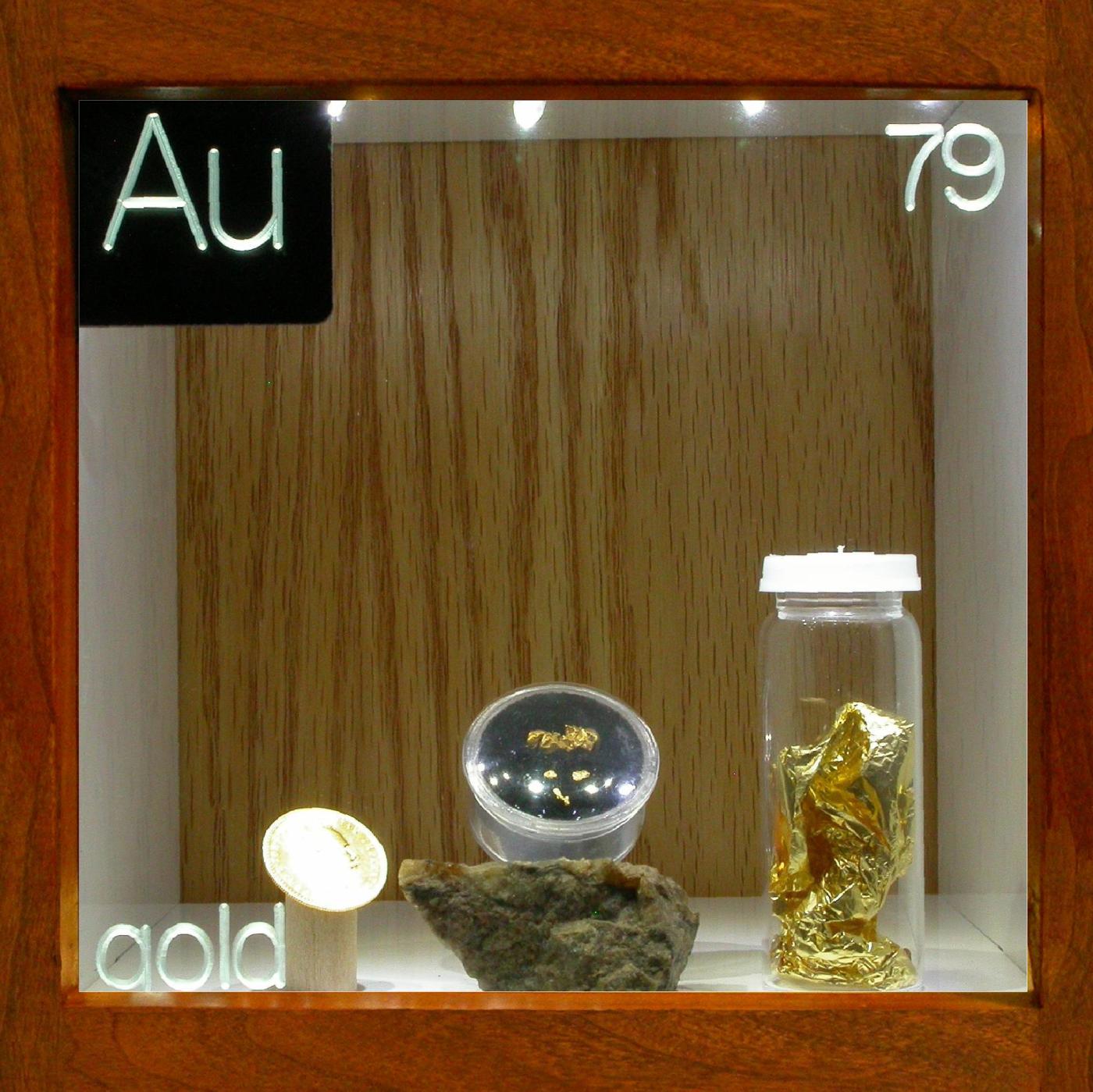Home Size: 1 2 3 4 5 6 7 8 9
|
 |
| A beautiful shiny, golden, very dense precious metal which is highly resistant to corrosion and very easy to work. Used as a store of economic value.
|
|
|
 |
Leaf.
Gold is the most malleable element. It can be beaten into an incredibly thin film called leaf which is contained here inside the glass bottle. Without protection this gossamer sheet would be blown around and quickly broken by the slightest air current. A piece of gold the size of a small sugar lump (half and inc on each side) can be beaten into a sheet of leaf capable of covering an area of 400 square feet! Gold leaf is brushed onto objects to gild them.
Source: Artists supply store
Size: 4" x 4"
Purity: 99.9%
|
|
 |
Coin.
The ducat was a unit of account, as well as a gold coin, once widely used throughout Europe. The first ducats were issued by the city state of Venice under Doge John Dandolo in 1284. These Venetian ducats feature a figure of Christ in the Heavens on one side and the Doge kneeling before St Mark on the other. The first Austrian ducats were issued in 1612, with the last issue for circulation being minted in 1914, shortly before the outbreak of the First World War. Like all 1915 dated ducats, this piece is a restrike struck for bullion purposes after the war. The obverse shows the laureate portrait of the penultimate Hapsburg Emperor, Franz Joseph I on the obverse and the arms of Austria superimposed upon a double-headed imperial eagle. The ducat was one of the highest purity gold coins issued for circulation at 23.75 carats fine, 0.986 gold. Because the design was based on medieval hammered coins, ducats are much thinner than modern coins at 0.8mm thick.
Source: Coin shop
Size: 0.5%
Purity: 98.6%
|
|
 |
Placer grains.
Gold was probably the first metal known to man, with the earliest decorative objects dating from the early Stone Age. Because it is such an inert metal it usually occurs in nature in the uncombined state. Most gold mined is finely distributed through the host rock, so finely that it cannot be distinguished with the naked eye. Visible masses are formed when gold precipitates out of hot mineral rich solutions, collecting in cracks and fissures in the host rock or through the decomposition of gold bearing sulfide minerals. When the primary host rock is eroded away the gold collects in secondary placers in stream or river beds. This can be in the form of fine gold dust right up to substantial and valuable nuggets. The record size for a gold nugget is still held by The Welcome Stranger, a 2,284 troy ounce monster found in 1869 in Moliagul, Victoria, Australia!
Source: eBay
Size: 0.05"
Purity: <96%
|
|
 |
Native gold nugget.
Gold nuggets often look as though they have been melted at some point in their existence, although this is hardly ever the case - until they're found, that is. As the surrounding matrix is eroded away holes and pits are left in the gold, which when further worn down and polished by water action gives the characteristic 'nugget' appearance. Nuggets represent only a small proportion of the total gold recovered worldwide. Even rarer are gold crystals - gold can form elaborate arborescent (tree-like) crystal groups, cubic and octahedral crystals, plates, sheets and leaves, sometimes studded with exquisite little trigonal crystals, wires and mossy deposits. Most naturally occurring gold is 87.5 to 95.8% pure. Gold containing more than 20% silver is known as electrum and it is this metal which was used to strike the first coins in Lydia in Asia Minor in 630BC.
Source: Mackay mineral collection
Size: 0.5"
Purity: <96%
|
|
 |
Sylvanite and Calaverite.
Gold, like the platinum metals, is an element more commonly found in nature in the uncombined state than as a compound. Gold minerals do exist however, almost thirty of them. This specimen contains two - sylvanite, a gold-silver telluride and calaverite, gold telluride. Both are soft metallic minerals - sylvanite, containing 34.36% gold, is white or silver-white with a yellowish tinge and calaverite, containing 43.56% gold, is yellow to yellowish white.
Source: Mackay mineral collection
Size: 1.5"
Purity: 40%
|
|
|

